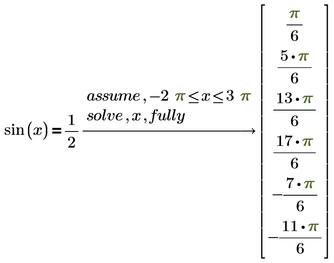- Subscribe to RSS Feed
- Mark Topic as New
- Mark Topic as Read
- Float this Topic for Current User
- Bookmark
- Subscribe
- Mute
- Printer Friendly Page
Round trip operators and functions
- Mark as New
- Bookmark
- Subscribe
- Mute
- Subscribe to RSS Feed
- Permalink
- Notify Moderator
Round trip operators and functions
- Labels:
-
Other
- Mark as New
- Bookmark
- Subscribe
- Mute
- Subscribe to RSS Feed
- Permalink
- Notify Moderator
Your first round trip involves assigning a value to a variable, and retrieving that value when calling that variable. It's not a 'simple' variable, I know it's a matrix, but it's a variable anyway.
Your second round trip essentially defines a function, at least, it appears to do so. The definition:
sin(x):=0.5
States that, no matter what value x may have, sin(x) will always result in 0.5. The second part of this round trip could (better?) be:
And that shows that there's not one unique value of x for which sin(x)=0.5.
But in fact what you did is assign the value 0.5 to the variable named sin(x). This variable has no relation to a variable x whatsoever. It's similar to assigning:
and then wondering what the value of b might be:
Success!
Luc
- Mark as New
- Bookmark
- Subscribe
- Mute
- Subscribe to RSS Feed
- Permalink
- Notify Moderator
Prime 6
- Mark as New
- Bookmark
- Subscribe
- Mute
- Subscribe to RSS Feed
- Permalink
- Notify Moderator
You forgot about sin(5 *pi /6), etc. 😉
In the meantime its well known and shown by quite some examples here in the forum that the new symbolic engine is much less capable than the old ones (muPad and even older Maple).
But as you are using Prime 6 you are lucky and can switch back to muPad at least (you can get rid of the second unnecessary "_n in Z" by adding the modifier "simplify").
or
Try the last one with the new engine for a funny experience.
- Mark as New
- Bookmark
- Subscribe
- Mute
- Subscribe to RSS Feed
- Permalink
- Notify Moderator
An example with a sinus is not very successful.
Here is a good example of a double-sided simple operator.
- Mark as New
- Bookmark
- Subscribe
- Mute
- Subscribe to RSS Feed
- Permalink
- Notify Moderator
Why not
- Mark as New
- Bookmark
- Subscribe
- Mute
- Subscribe to RSS Feed
- Permalink
- Notify Moderator
> An example with a sinus is not very successful.
It was yours, not mine 😉
> Here is a good example of a double-sided simple operator.
?????
> Why not
Again - a matter of definition!















